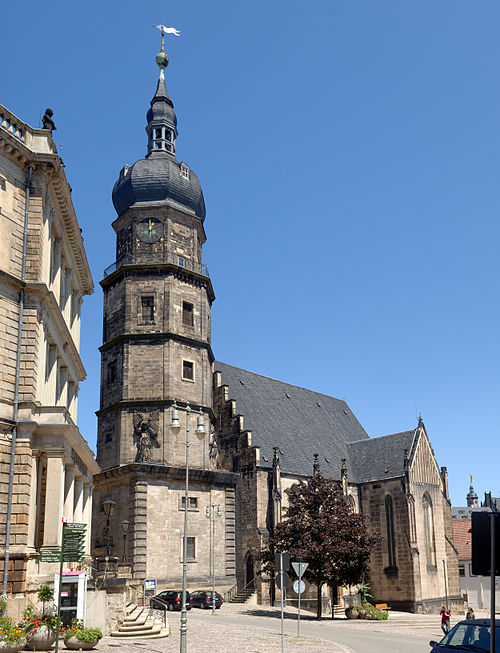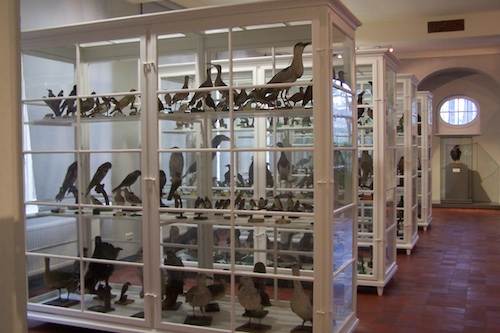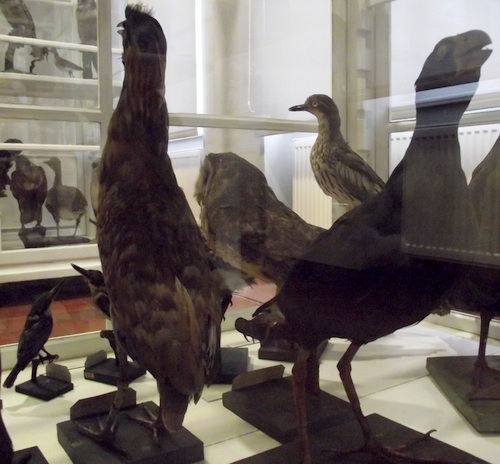On the ‘5th Sunday after Epiphany 1838’ ((This is the date as given in the full title of the Darstellung der Ordinationsfeier, edited by Dr Fr Hesekiel, 1838. Altenburg: Pierer. This date correspondes to 4 February 1838)) two Lutheran missionaries from the Dresden Missionary Society, Christian (Gottlieb|Gottlob)[see comments below] Teichelmann and Clamor WIlhelm Schürmann, were ordained in Altenburg, the capital of the small central German duchy of Sachsen-Altenburg. They were being sent to establish a mission to the Aborigines of South Australia, but the spreading of the gospel was not to be their only occupation. Their trip awakened the interests of Altenburg’s legion of amateur and semi-professional scientists – a common fixture of many German cities of the time – who were eager to hear reports and receive specimens from a far-off, exotic land. The missionaries were urged in their official instructions to collect ‘specimens of the products of South Australia’ for the missionary society’s scientific friends:
If you can support the works of the mission in Europe by sending, without too much cost, some specimens of the products of South Australia for the friends of our society who research the natural world, then we would hope that you will not want to withdraw from this labour of love for the advancement of science. ((‘Können Sie … das Missionswerk in Europa dadurch fördern, ohne bedeutende Kostenaufwand, von den Produkten Süd-Australiens für die Naturforschenden Freunde unserer Gesellschaft einige Exemplare übersenden, so wünschen wir, dass Sie sich in diesem Liebesdienste zur Beförderung der Wissenschaft nicht entziehen wollen.’ Instruktionen für die beiden Missionare der evangelisch-lutherischen Missions-Gesellschaft zu Dresden, Chr. G. Teichelmann aus Dahme (Herz. Sachsen) und Clamor W. Schürmann aus Schledehausen (bei Osnabrück.), p.682. In Rheinwald, George Friedrich Heinrich. 1840. Acta Historico-Ecclesiastica, Seculi XIX. Hamburg: Friedrich Perthes, pp.676-682.))

Church St Bartholomäi, Altenburg, where Teichelmann and Schürmann were ordained. Photo by André Karwath.
Among the beneficiaries of the missionaries’ scientific work was the local nobleman and government minister Hans-Conon von der Gabelentz, ((The son of Hans-Conon von der Gabelentz, Georg von der Gabelentz, went on to have a successful career as a linguist and sinologist. He often cited the influence of his father on his view of language. It has been claimed that as a particularly influential teacher of Saussure in Leipzig he could be considered a grandfather of structuralism, which, I suppose, makes Hans-Conon von der Gabelentz a great grandfather. See: Coseriu, Eugenio. Georg von der Gabelentz und die syncrhonische Sprachwissenschaft, in Gabelentz, Georg von der. 1972[1901]. Die Sprachwissenschaft: ihre Aufgaben, Methoden, und bisherigen Ergebnisse. Tübingen: Tübingen Beiträge zur Linguistik, pp.3-35. French original: 1967. Georg von der Gabelentz et la linguistique synchronique. Word 23, pp.74-110.)) whose passion was researching the languages of the world. He established a correspondence with Teichelmann over linguistic matters in South Australia. So far one letter from Teichelmann to Gabelentz has come to light, and there are undoubtedly many more waiting to be found. Gabelentz made active use of Australian data in his general linguistic work. In his monograph Über das Passivum (1861), an early typological work on the passive, he mentions data from Parnkalla and Kaurna from South Australia (citing materials from Teichelmann and Schürmann, as well as their fellow missionary Meyer) and Awakabal from New South Wales (citing ‘Threlkeld’s Grammar’).
The physical specimens that the missionaries collected were sent to the Naturforschende Gesellschaft des Osterlandes. The Naturforschende Gesellschaft was an amateur scientific society whose main aim was to research the natural history of the local area. Osterland is originally a historical designation for a region in what is now eastern Germany, but the society used the term as a romantic name to describe the area from the River Saale to the Erzgebirge, which could perhaps be more prosaically called ‘Greater Saxony’. Although their focus was on the local area, they were very excited about receiving specimens from afar, as their official report on the reception of birds Teichelmann collected for them shows:
However the most important delivery in terms of the number of specimens and their beauty and value we received last week from Missionary Teichelmann in South Australia. You [those present at the delivery of the report] have undoubtedly observed these today with pleasure at the society’s premises. The delivery consists of 336 specimens of around 170 species, which are all without exception new to our collection. The complete worth cannot be judged until the animals can be identified and valued in terms of their relative rareness in comparison with their size and beauty. In any case, these animals have a very significant worth. And for these treasures we owe our thanks to the care, diligence and selfless service of our honoured friend in Adelaide. ((‘Die an Zahl, Schönheit und Kostbarkeit der Gegenstände bei weitem wichtigste Sendung jedoch erhielten wir vergangene Woche aus Süd-Australien durch den Missionar Herrn Teichelmann. Sie haben sie heute im Gesellschaftslocal gewiß mit Vergnügen bertrachtet. Dieselbe besteht aus 336 Exemplaren in etwa 170 Arten, sämtlich ohne Ausnahme für unsere Sammlung neu. Der vollständige Werth läßt sich nicht eher beurtheilen, als bis die Thiere bestimmt und nach ihrer relativen Seltenheit, im Vergleich mit ihrer Größe und Schönheit geschätzt seyn werden. Jedenfalls aber haben diese Thiere einen sehr bedeutdenden Werth. Und diese Schätze verdanken wir der Umsicht, Gewissenhaftigkeit und überaus großen Gefälligkeit unsers geehrten Freundes in Adelaide.’ Apetz, J H. 1844. Jahresbericht der Naturforschende Gesellschaft des Osterlandes. Mittheilungen aus dem Osterlande, 7, p.66.))

Display cases containing birds collected by Teichelmann, Naturkundemuseum Mauritianum, Altenburg. Photo by Mary-Anne Gale.

Birds collected by Teichelmann in the Naturkundemuseum Mauritianum, Altenburg. Photo by Gerhard Rüdiger.
Unfortunately, this contact between Adelaide and Altenburg ended with Teichelmann and Schürmann’s mission to South Australia. The objects and documents that they sent back to Altenburg have had to withstand some trying times, with the various turbulent events that have shaken little Altenburg over the past one hundred and fifty years. The most significant of these are the Second World War and its aftermath. The von der Gabelentz family library, which was considered to be one of the greatest collections of books on non-European and especially East Asian languages, was largely transported to Moscow and Leningrad as war reparations. And many of the natural history specimens and papers that the missionaries sent to Altenburg lay neglected during the time of the GDR.
But the scientific heirs of Altenburg, the staff of the Naturkundemuseum Mauritianum and the Thüringische Staatsarchive Altenburg, have begun to open up and explore the old collections. And contact between Adelaide and Altenburg is also being re-established. Late last year and again earlier this year, I accompanied Rob Amery, the convener of the Kaurna Warra Pintyandi (KWP) group at the University of Adelaide, and Gerhard Rüdiger, who is researching the history of the Dresden Missionaries in South Australia, on visits to Altenburg. The high point was a talk that Rob Amery gave in the Mauritianum about Kaurna language revitalisation, which was very well attended. Later this year the Kaurna and Ngarrindjeri peoples will be sending a delegation to Germany for the 175th anniversary of the Dresden Missionary Society and to gather their own impressions of this far-off, exotic land.
My thanks to Rob Amery and Gerhard Rüdiger for reading this blog post and making comments and providing additional information that led to its improvement.
 Follow
Follow
Wonderful story!
One correction – the ADB gives the wrong second name for Christian Teichelmann – he was Gottlob, not Gottlieb.
@Jane: Thanks for the correction. I’ve incorporated it into the main post.
TEICHELMANN, CHRISTIAN GOTTLIEB born on 15 December 1807 at Dahme, Saxony, son of Friedrich August Teichelmann, my family have a journal & photograph.contact me
Teichelmann’s middle name seems to be an issue of a mystery. The most extensive biography about him and his extended family was written by an in-law, Bruce Kennedy (1989, never published, though, beyond private printing). He is the most consistent writer in giving T’s middle name as “GottlÖb” (with the German O-Umlaut). In the context of the failed naturalization attempt of the first Germans in SA, Bruce reflects upon name changes, e.g. Gottlöb > Gottlieb or Schürmann > Schurmann (page 20):
However, the report of the examination and ordination of S&T at Altenburg 1838 names T as “Gottlieb”, that would prove Kennedy’s assessment wrong.
T himself seems to have his middle name abbreviated as “Gottl.”, or both surnames as “C.G.”.
I have seen versions of T’s middle name as Gottlöb and Gottlob (Praise God), Gottlieb (loved by / or love God) and Gottleib (body of God or similar). T was buried as “Gottlieb” (Stansbury, Yorke Peninsula cemetery) — thus we should let him live by this name.
@all: Thanks to everyone for the interesting discussion about Teichelmann’s middle name. The main post has been modified to point people to the discussion down here.
As this discussion has been going on over the weekend, some more aspects have come to light:
* Teichelmann himself signed his handwritten autobiography in 1836 with the middle name “GottlOb”. He also signed most of his earlier letters with Gottlob, while he abbreviated his given names later to “C.G.”, “Chr.G.” or “Christian Gottl.”. His fellow missionary, Clamor Schürmann (or Schuermann, or Schurmann, or Shurman) gave the same name in the obituary for Teichelmann in 1888.
* If at all, most contemporary newspaper articles and publications use “Gottlieb” as the middle name, as he must have been known widely.
Genealogy experts and historians seem to consider death certificates and tombstones, so I was told, as the most notoriously inaccurate of all genealogical data.
This leaves open the question about our use of Teichelmann’s middle name today — we either accept his own use of “Gottlob” or take “Gottlieb” as the name under which he seems to have widely been known.
By the way, “Gottlieb” is an Old High German name, derived from “got=God” and “leip=heir”, while “Gottlob” means “praise God”. Both names seem to have been neologisms in Pietistic Southern Germany in the 17th/18th century (http://www.kirchenweb.at/vornamen/, in German)
When I was pursuing the -lieb/lob earlier, Lee Kersten wrote to me (Mon, 15 Jan 2007) saying:
“It’s Gottlob. For instance he signs as Christian Gottlob Teichelmann at the end of a letter from Adelaide on 18th November 1839 – handwritten, on p. 133 of his ‘Tagebuch’ which is held as photocopy in the Lutheran Archives here in Adelaide. The Tagebuch has various other examples of him as ‘Gottlob’ in its typewritten form sent to South Australia from Leipzig Lutheran archive before German unification in 1989….Teichelmann’s writing is very clear.”
That’s the source of my 99.9% confidence weighting
An article containing excerpts from another letter from Teichelmann to von der Gabelentz has come to light. A transcription and English translation of the text can be found at:
http://pfed.info/james/Teichelmann-Gabelentz_translation-20110518.pdf
What an interesting story! I had no idea.
If you are interested in further contacts with Altenburg, pls contact me.
abg
I am a direct decendant of Christian Gottlieb Teichelmann, his son Friedrich August (named after Christians father) was my great Grandfather. I just visited the area on the Yorke Peninsula in South Australia where Christian lived and farmed with his sons for a number of years. I did not know that he sent specimens of birds back to Altenburg. Next time I am in Germany I will make a point of visiting the Naturekundemuseum Mauritianum in Altenberg.
Thanks for this wonderful posting which I found so emlightening. I wrote a book on Gottlieb’s son, Ebenezer, who was a truly remarkable man. I have a website on Ebenezer:
http://ebenezerteichelmann.blogspot.com
Would I be able to run your post on my blog with full acknowledgements for the great work you have done?
Best wishes
Bob McKerrow
Abg, Roslynn Scheuch and Bob McKerrow,
and everybody else interested in this story,
even though this blog discussion is more than three years old, if you are interested in further details on this story, or have information and documents from/about missionary-linguist-pastor C G Teichelmann that where handed down to you through your family, would you please contact me for sharing at . I am working with the Kaurna Language reclamation program “Kaurna Warra Pintyanthi” (KWP) , and we are quite interested finding Teichelmann’s personal collection of letters, books and – in particular – his language research notes.
Many thanks, Gerhard